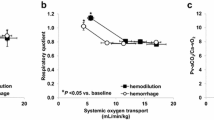Abstract
Simultaneous superior vena caval (SCvo 2) and mixed venous (\(S\bar vo_2 \)) oxyhemoglobin saturation values in 15 children recovering from open heart surgery were compared to assess the value of superior vena caval blood samples in monitoring systemic oxygen supply/demand balance. Samples were obtained immediately following the operation and postoperatively every morning for 4 days. During the 4-day study period, the patients' cardiopulmonary functions improved, allowing partial weaning from respiratory and cardiovascular support. The lowest values of superior vena caval (46.7±8.4%) and mixed venous (63.7±10.9%) oxyhemoglobin saturation were measured immediately after the operation. At this time, 6 patients had abnormally lowSCvo 2 values, but normal\(S\bar vo_2 \) values. BothSCvo 2 and\(S\bar vo_2 \) increased; the difference between them decreasing significantly during the study period (P<0.001). The results show thatSCvo 2 is consistently lower than\(S\bar vo_2 \) in children recovering from open heart surgery. This difference may be secondary to residual intracardiac left-to-right shunting of blood or to altered distribution of systemic blood flow. The saturation difference between the two venous samples decreases during postoperative recovery, making a superior vena caval blood sample an inadequate substitute for a mixed venous blood sample in calculating derived cardiopulmonary variables intended to reflect the function of the body as a whole. BecauseSCvo 2 was frequently subnormal while\(S\bar vo_2 \) was in the normal range, monitoring of\(S\bar vo_2 \) could not be reliably used to rule out oxygen supply/demand imbalance during the early postoperative period in these patients.
Similar content being viewed by others
References
Reinhart K, Kersting K, Föhrung U, et al. Can centralvenous replace mixed-venous oxygen saturation measurements during anesthesia? In: Longmuir S, ed. Oxygen transport to tissue, vol. 8. New York: Plenum, 1986:67–72
Reinhart K, Schäfer M, Specht M. Indications and limitations of\(S\bar vO_2 \) andSCvO2 monitoring. In: Vincent J-L, ed. Update in intensive care and emergency medicine 5. Heidelberg: Springer-Verlag, 1988:428–435
Davies GG, Mendenhall J, Symreng T. Measurement of right atrial oxygen saturation by fiberoptic oximetry accurately reflects mixed venous oxygen saturation in swine. J Clin Monit 1988;4:99–102
Nelson LD. Continuous venous oximetry in surgical patients. Ann Surg 1986;203:99–103
Orlando R. Continuous mixed venous oximetry in critically ill surgical patients. ‘High tech’ cost-effectiveness. Arch Surg 1986;121:470–471
Rah KH, Dunwiddie WC, Lower RR. A method for continuous postoperative measurement of mixed venous oxygen saturation in infants and children after open heart procedures. Anesth Analg 1984;63:873–881
Schranz D, Schmitt S, Oelert H, et al. Continuous monitoring of mixed venous oxygen saturation in infants after cardiac surgery. Int Care Med 1989;15:228–232
Barratt-Boyes BG, Wood EH. The oxygen saturation of blood in the venae cavae, right heart chambers, and pulmonary vessels of healthy subjects. J Lab Clin Med 1957;50:93–105
Keith JD. Cardiac catheterization. In: Keith JD, Rowe RD, Vlad P, eds. Heart disease in infancy and childhood. New York: MacMillan 1978:97–98
Tahvanainen J, Meretoja O, Nikki P. Can central venous blood replace mixed venous blood samples? Crit Care Med 1982;10:758–761
Settergren G, Ohqvist G, Lundberg S, et al. Cerebral blood flow and cerebral metabolism in children following cardiac surgery with deep hypothermia and circulatory arrest. Clinical course and follow-up of psychomotor development. Scand J Thorac Cardiovasc Surg 1982;16:209–215
Smith AL, Wollman H. Cerebral blood flow and metabolism: effects of anesthetic drugs and techniques. Anaesthesiology 1972;36:378–400
Author information
Authors and Affiliations
Rights and permissions
About this article
Cite this article
Räsänen, J., Peltola, K. & Leijala, M. Superior vena caval and mixed venous oxyhemoglobin saturations in children recovering from open heart surgery. J Clin Monitor Comput 8, 44–49 (1992). https://doi.org/10.1007/BF01618087
Received:
Revised:
Accepted:
Issue Date:
DOI: https://doi.org/10.1007/BF01618087




